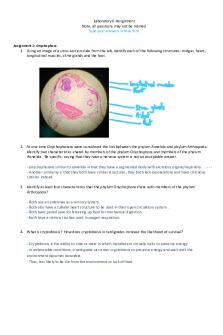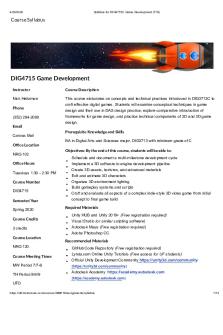Embyology - Development of Amphioxus for developmental zoology PDF

| Title | Embyology - Development of Amphioxus for developmental zoology |
|---|---|
| Author | Sruthi V.Pillai |
| Course | Applied Zoology I |
| Institution | Osmania University |
| Pages | 8 |
| File Size | 568.3 KB |
| File Type | |
| Total Downloads | 336 |
| Total Views | 622 |
Summary
Development of AmphioxusIntroduction:Amphioxus is an oviparous animal and has an indirect development producing a free living, ciliated and self-nourishing lava, which has to undergo the process of metamorphosis to become an adult like creature.Egg :1 : The egg of Amphioxus is microlecithal and isol...
Description
Development of Amphioxus
Introduction: Amphioxus is an oviparous animal and has an indirect development producing a free living, ciliated and self-nourishing lava, which has to undergo the process of metamorphosis to become an adult like creature.
Egg : 1 : The egg of Amphioxus is microlecithal and isolecithal type. 2 : The nucleus is almost centric because the yolk content is very less and does not affect the nucleus of the egg considerably. 3 : It can be differentiated into upper animal hemisphere and lower vegetal hemisphere containing animal pole and vegetable pole respectively.
Sperm: 1. The sperm of Amphioxus is extremely minute about 4μ in length and consist of a beak or acrosome, a head with a large compact nucleus, a neck or middle piece and a very long vibratile tail.
Figure- Amphioxus: A. Unfertilized egg.
B. Sperm
FERTILIZATION: Only one sperm can fuse with the egg. It is not yet known whether the entire sperm enters the egg or only the head enters. After the entry of sperm the membrane becomes fibrous and is called fertilization membrane. A fluid filled space then appears between the fertilization membrane and the cell membrane. The fertilization membrane prevents the entry of more sperm. The chromosome of the egg and sperm come very close, develop a nuclear membrane around them and form a single nucleus- zygote nucleus. The egg is then called the zygote .
CLEAVAGE: It is complete, i.e., holoblastic, which divides the egg completely into blastomeres. 1. First cleavage plane is maridional that is passing through the animal pole to vegetal pole axis forming two equal blastomeres. 2. Second plane of cleavage is also meridional but at right angle to the first one forming four equal sized blastomeres. 3. Third plane of cleavage is latitudinal, which is slightly above the equatorial plane , The product is the 8-cell stage of which four upper are smaller cells called micro mere and four lower larger are called megameres 4. Fourth set of cleavage is meridionall forming 16 cell stage. 5. Fifth set of cleavage is latitudinal forming 32 cells in four tiers. 6. Sixth set of cleavage is meridiona forming 64 cell stage. 7. The cleavage till now is synchronous, i.e., all cells at a particular cleavage divide at a time. 8. The cleavage plane on seventh cleavage onwards is asynchronous, i.e., all cells at particular cleavage do not divide at a time. 9. As the division advances, the embryo is converted into a solid ball of cell called as morula. 10. Soon a small cavity appears in the interior of the embryo. It becomes fluid filled and expands gradually pushing the cells on periphery and as a result a hollow ball of cells is formed having a spacious fluid filled cavity called blastocoel surrounded by a single layer of cells. This is called Blastula.
2
Cleavage and blastulation in Amphioxus- A-Fertilized egg, B. Mitosis of 1st cleavage. Cnuclear division. D-Two cell stage.E-Four cell stage. F-Eight cell stage. G-sixteen cell stage. H-Thirty cell stage. I- Morula stage. J-Blastula stage.
FATE MAP The different parts of Amphioxus embryo at 32 cell stage have got following fates;
3
1. Most of the area of the vegital hemisphere cell is responsible for the formation of Endoderm. 2. Above this is a crescent shaped area responsible for the formation of mesoderm. 3. Above this at one side is responsible for the formation of notochord. 4. Above the notochord area, lies the neural ectoderm area.
Fate Maps of Amphioxus (Branchiostoma) belcheri at the eight-cell stage (A) and at the 32-cell stage (B)
GASTRULATION : Gastrulation is a process by which the monoblastic blastula is converted into a structure containing well-defined three germinal layers, from which different organs can be formed. It can be dealt under following stages; A.
Invagination of the prospective endoderm and formation of the blastopore. 1. Invagination is a process in which the layer of cells itself goes into the interior of the developing embryo. 2. This process starts at vegetal pole. 3. Initially the invaginating cavity is very small but gradually it deepens into the blastocoel. 4. The new cavity is called Archenteron. As the archenteron advances, the old cavity (blastocoel) starts Obliterating.
4
5. The archenteron communicate to outside by a pore called blastopore. 6. Initially the blastopore is a small pore but very is soon it becomes a well developed structure and can be divided into three lips- one dorsal, two lateral and one ventral.
B. Involution of chord -mesoderm. 1. In the advance distance of invagination that that’s the lip of the blast to poor is flanked by the prospect of notochord cells, while data when trailing by the prospective mesodermal cells. 2. Then auto chordal cells move inside the process of involution to take the dorsal position in the developing embryo. 3. The mesodermal cells move inside by the process of involution through the ventral lip of the blaster pore and take the ventral position in the developing embryo.
C.
Stretching of the embryo in the anterior posterior direction.
Now the embryo is stretched in the anterior posterior direction, which causes the stretching of notochord in the axis of the body and it occupies the roof of the archenteron from anterior to the posterior end. Mesodermal mass is also stretched so that it occupies the laterodorsal position in the developing embryo.
D. Closing of the blastopore. After the completion of the invagination and involution the blastopore starts diminishing and finally leaves a narrow crevices.
Structure of a fully formed gastrula: A fully formed gastrula of Amphioxus contains well-defined three terminal layers, the ectoderm, mesoderm and endoderm. The upper portion is covered by neural ectoderm and all sides by the epidermal ectoderm. A spacious cavity called archenteron is present in the interior of the embryo which contains various cell types at various portions: a.
Roof is formed of notochordal cells.
b.
Sides contain mesodermal cells.
c.
Rest is endodermal.
5
So, in this way we can say that a single layered blastula is converted into a double layered structure having distinguished three germ layers.
Figure- Gastrulation of Amphioxus: A series of consecutive stages.
TUBULATION:
It is the formation of organ rudiments from three germinal layers, so that organ can develop from them. a.
Neurulation- formation of neural tube
b.
Notogenesis- formation of notochord.
c.
Mesogenesis- formation of mesoderm.
d.
Development of endoderm and formation of alimentary canal.
6
Figure- Neurulation in Amphioxus: Transverse section of Amphioxus embryo to show the formation of neural tube, notochord, coelom and gut. 1. The upper surface of the embryo, which is the neural ectoderm starts thickening due to the change in cell shape, called neural plate. 2. The neural plate invaginates to form a neural groove flanked by neural folds. 3. Soon the groove is closed into a tube from anterior to posterior end of the embryo. 4. Anteriorly the neural tube opens outside by a neuropore. 5. Posteriorly also there is a canal covered by upcoming epidermal ectoderm called the neurocentric canal. Later on the anterior portion of the tube makes brain and the posterior makes the spinal cord.
7
NOTOGENESIS The roof of the Archenteron is invaginated to form a closed structure called notochordal cord. Later on it develops into a notochord just below the neural tube and above the alimentary canal.
MESOGENESIS The lateral portions on both sides are evaginated to form a cord of cells from anterior to posterior end containing a space derived from the archenteron called as Coelom. Later on the cord is cut off in different segments to form somites.
Development of endoderm and alimentary canal: After the cutting of cellular masses of notochord and mesoderm the remaining portion of inner layer of embryo flanks the cavity and called as endoderm, while the cavity later on develops into alimentary canal.
.
8...
Similar Free PDFs

Digestive system of Amphioxus
- 7 Pages

Branches of Zoology PDF
- 8 Pages

Principles of systematic zoology
- 10 Pages

ZOOLOGY VERTEBRATA
- 52 Pages

zoology biology lab 6
- 6 Pages

Syllabus for Game Development
- 13 Pages

Zoology Lab Paper - Grade: A+
- 5 Pages

Developmental psychologyy
- 4 Pages
Popular Institutions
- Tinajero National High School - Annex
- Politeknik Caltex Riau
- Yokohama City University
- SGT University
- University of Al-Qadisiyah
- Divine Word College of Vigan
- Techniek College Rotterdam
- Universidade de Santiago
- Universiti Teknologi MARA Cawangan Johor Kampus Pasir Gudang
- Poltekkes Kemenkes Yogyakarta
- Baguio City National High School
- Colegio san marcos
- preparatoria uno
- Centro de Bachillerato Tecnológico Industrial y de Servicios No. 107
- Dalian Maritime University
- Quang Trung Secondary School
- Colegio Tecnológico en Informática
- Corporación Regional de Educación Superior
- Grupo CEDVA
- Dar Al Uloom University
- Centro de Estudios Preuniversitarios de la Universidad Nacional de Ingeniería
- 上智大学
- Aakash International School, Nuna Majara
- San Felipe Neri Catholic School
- Kang Chiao International School - New Taipei City
- Misamis Occidental National High School
- Institución Educativa Escuela Normal Juan Ladrilleros
- Kolehiyo ng Pantukan
- Batanes State College
- Instituto Continental
- Sekolah Menengah Kejuruan Kesehatan Kaltara (Tarakan)
- Colegio de La Inmaculada Concepcion - Cebu







